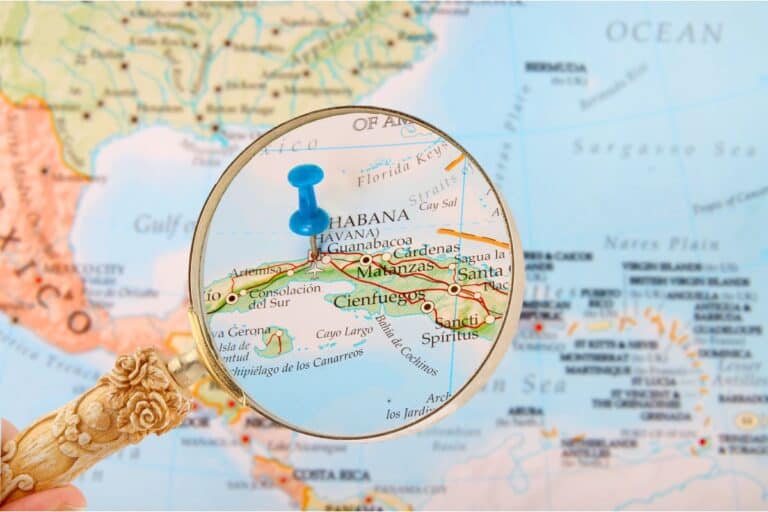Eating Gluten Free in Cuba is Possible – Here’s How
Packed for Life contains affiliate links. If you make a purchase using one of these links, we may receive compensation at no extra cost to you. As an Amazon Associate, I earn from qualifying purchases. See my Disclosure policy for more info.
Whether eating gluten free is a lifestyle choice or an absolute necessity due to celiac disease or other health concerns, eating abroad can bring many challenges and some surprising opportunities.
If you have been eating gluten free for awhile, you will be used to limited options, and watching what you eat. However that doesn’t mean you will starve in Cuba. Eating gluten free in Cuba is possible with a little preparation. Here’s how:
- Eat more traditional Cuban food
- Choose foods that are already typically gluten -free
- Bring a Gluten- Free Restaurant Translation Card
- Pack your favorite gluten free snacks from home
Check out our suggestions for safe and delicious gluten-free food options
We have also summarized our top 5 tips for eating gluten-free at any resort. While they aren’t specific to Cuba, they will help you have a more pleasant and relaxing stay on your all-inclusive Cuban vacation.
Traditional Cuban Food
Cuban food culture has many influences, from it’s tropical island location, to its history of the people who settled there, and the impact of the Cuban revolution. Cuban food is strongly influenced by Spanish, African, Taino and Carribean cuisines. A not insignificant Chinese influence in the mid 1800’s, mainly in Havana led to the introduction of rice, which is a staple today.
Fresh ingredients are prepared simply and meals are heavy on the meat. Their food staples focus on rice, beans, pork, beef, chicken, eggs and small amounts of vegetables. Vegetables are often tomatoes, cabbage, lettuce, cucumbers, cassava (yucca) and plantain.
During our Cuba travels we noticed vegetables were hard to come by and were often served more as a garnish than a main component of a meal we were used to. Fried plantains, a more starchy banana were often served on the side and were delicious when made as tostones ( green plantain circles fried in a pan and smashed).
Access to spices and processed or commercially prepared food is limited, which makes the chances of being exposed to gluten and gluten-filled flavor enhancers less likely when eating more traditional Cuban foods.
HOW TO EAT GLUTEN FREE IN CUBA: Gluten Free Food Options
You will find that many restaurants and resorts don’t fully understand the issue with gluten and cross contamination. If you or your travel partner(s) aren’t fluent in Spanish, it can be difficult to communicate your concerns and needs.
Bring a Gluten- Free Restaurant Translation Card explaining what being celiac / gluten free means in Spanish. Include descriptions of what you can and cannot eat, that different utensils and pans need to be used, and any other important details. A physical card that can be shown to your guides, wait staff and brought into the kitchen can help prevent misunderstandings, and provide you with peace of mind.
- Here is a handy credit card sized resource for travel cards. They have 50 different languages.
Choose foods that are already gluten free. Gluten free pastas, breads and other alternatives are extremely rare to non-existent in Cuba. So unless you bring these products with you, skip out on pasta, sandwiches, and pizza.
Pack your favorite gluten free, easy-to-keep-and-transport snacks from home. Finding snacks in Cuba was difficult. We went into a few grocery type stores which was an eye opening experience. Packaged food is expensive with limited choice, and not surprisingly gluten free items were non-existent.
You likely have your favorites, but these are the snacks we typically bring on our travels:
- Beef Jerky
- Packaged Trail mix
- Individual nut packages like roasted pistachios or crunchy almonds or nut mixes.
- Cheese Whisps
- Kind Breakfast Bars – Peanut are my daughter’s favorite
- Lara Bars
- Made Good granola minis or granola bars (chocolate chip are my kid’s favorite).
PRO TIP: Double check the food entry regulations as they change time to time, and you don’t want to have your food confiscated on entry. While we had no issues bringing in dried jerky / dried cheese products, there may be current restrictions.
Eating Gluten Free in Cuba: Breakfast
A typical Cuban breakfast consists of freshly made juice, cuban coffee / cafe con leche, fruit, scrambled or fried eggs, toast and a crepe like pancake. Skip the toast and pancake, and check to make sure the eggs aren’t also being cooked in the same pan as bread products and you have a delicious gluten free Cuban breakfast.
We stayed in Cuba for two weeks, in three different Casa Particulares and I never got tired of these breakfasts.
Each place had it’s own take on a Cuban breakfast and I loved it. One of my favourite things about breakfast was the plentiful fresh fruit and fruit juice.
Slices of pineapple, papaya, small bananas and other seasonal fruit had so much taste compared to what I was used to back home.


Gluten Free in Cuba: Lunch and Dinner
For lunch and dinner, pass on the sauce and anything deep fried, and go for fish or meat that is simply spiced with a little salt, pepper, herbs and garlic, then grilled, pan fried or barbecued.
Fresh fish and sea food such as red snapper, octopus, lobster, shrimp and giant prawns were readily available especially in Varadero and Havana where we were staying. These were often prepared simply, without heavy sauces, so made me feel comfortable ordering as a gluten free option. And they were delicious!
Rice and Beans are common sides for main dishes and are generally safer choices. Double check the beans, as occasionally a spice pack is used, that may or may not contain gluten.
Gluten Free in Cuba: Snacks
Eat your favorite gluten free easy-to-keep-and-transport snacks you brought from home – nuts, dried fruit, peanut butter, crackers, protein bars, instant oatmeal etc.
We brought nuts, gluten free beef jerky, lara bars and protein bars and had no problems bringing these snacks into the country.
We have heard that sometimes food items are confiscated at customs. Its always best to double check what’s allowed or not allowed through their customs website.
Gluten Free in Cuba: Drinks
Bottled water, and freshly made juice are great options. There is nothing better than a freshly made glass of guava, pineapple, or papaya juice to quench your thirst in the hot sun. Except maybe a mojito, for those of a certain age.
Mojitos and unflavoured Cuban Rum are gluten free, but we don’t recommend subsisting on a diet of these alone.
You may also find these Cuba tips & ideas helpful:
- One Day Havana Itinerary
- How to get WIFI & Internet in Cuba (For Tourists)
- Varadero Kid (and adult) Friendly Things to Do
5 Tips for Eating Gluten Free at a Resort
As we didn’t stay at a resort in Cuba, I can’t speak to the food from personal experience, however I have heard good things about some of the options at higher end resorts and hotels. These tips are great for any resort, including the ones in Cuba.
1. Do your research
Spend some time doing your research. There are a lot of helpful online sources for resort reviews through social media, travel forums and blogs. People love to talk about their food experiences. I can relate, so do I.
Check out online menus to see what gluten free items may be available for your top resort choices. Choose resorts that have unlimited à-la-carte dining, as some limit the number of times you can chose this option.
2. Call or email the resort ahead of time
Call or email the resort first to ask important questions, which will help determine if the resort will be a safe and fun destination for your adventures.
- Is the resort aware of celiac disease / gluten-free?
- What policies and procedures are in place to prevent cross-contamination?
- How many gluten-free food options do they provide in their restaurant(s)?
- Do they have a Culinary Concierge who can help guide you to safe restaurant and food options?
3. Meet with the Chef or Culinary Concierge at the Resort
Meet with the Head Chef or Culinary Concierge at the resort, and let them know what your dietary needs are. Ask to review restaurant menus. They can let you know which restaurants are safe, which are not and what menu items you may need to order in advance. They can also give you the name of the manager / head chef at each restaurant to speak to.
4. Before each meal ask to speak to the manager / head chef
Speak with the manager and/or head chef before each meal to ensure they are aware of, and can accommodate your needs. Bring your Gluten- Free Restaurant Translation Card to avoid misunderstandings.
5. Choose the à-la-carte restaurants as much as possible
At à-la-carte restaurants you get one-on-one attention and avoid the increased cross-contamination risks of a buffet.
If you do choose to go to a buffet (or don’t have a choice), ask to speak to the head chef so they can explain which items are gluten free. Arrive at the beginning of the meal service to reduce the chance of cross contamination. Stick to what you know is safe; fresh vegetables, fruit, boiled eggs, and meat without sauce or cooked in front of you.
ENJOY
Most importantly slow down, and take the time to really enjoy what is available locally. Embrace your Cuban food, fun and sun adventure.
Leaving you with some final words of wisdom from my 6 year old. When in Cuba:
EAT ALL THE FLAN!
(It’s naturally Gluten Free)










Very captivating article, loved it. Since we cant travel now physically, blog posts like that make my life a bit brighter.
Me too. I am dreaming of travel to warm places, but I am glad to have already had some amazing experiences.
Thanks for the article–you mentioned that many restaurants and resorts don’t fully understand the issue with gluten and cross contamination, and I was curious if you did find a number that did seem to have a good understanding. Would be interested in know if eating gluten-free is becoming more trendy and well-known.
I think through tourism the concept in general is becoming more well known, especially larger centres like Havana and Varadero where there are more restaurant choices. However day to day for Cubans, as access to reliable sources of food is an issue and food shortages are common, it doesn’t seem to be a trend.